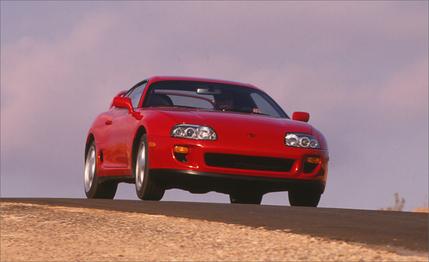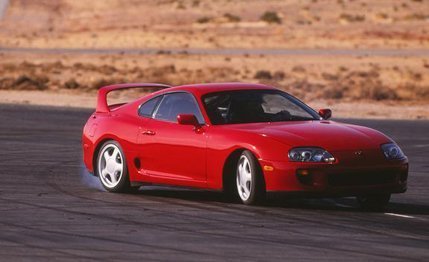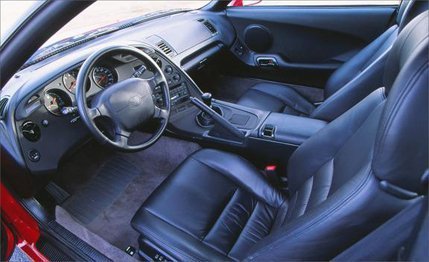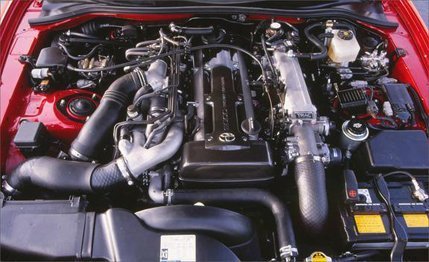 Archived Road Test
Archived Road Test
Toyota's first Supra was a bastard: the 110-horsepower progeny of the plain-Jane and little-loved Celica. We expected it to be orphaned quickly, describing it in 1979 as "a make-believe Monte Carlo" with "vapid steering and doughy suspension."
Much has changed.
Since 1979, the Supra has established its own, respectable family tree. And now we have a fourth-generation Supra—one that rushes to 160 mph rather than 110, and one that shares as many parts with a Celica as a Tappan oven shares with a Ferrari F40.
Which is apt, actually, because the 1993 Supra Turbo definitely cooks, and it steals more than a few F40 styling cues—the shape of its grille, its trapezoidal headlamp lenses, and its colossal brake scoops. Not to mention the plagiarized rear wing, which appears to have been unfastened from something manufactured by Aerospatiale but is, praise the Pharaohs, only an option. (As Joseph Campbell once said, "Not one shred of evidence exists that life is serious.")
The 1993 Supra shares its 3.0-liter inline six with the Lexus SC300 and GS300. The naturally aspirated iteration produces 220 horsepower at 5800 rpm. But with two turbos strapped to the iron block's starboard flank, it musters an additional 100 horsepower, as well as a pot-walloping 315 pound-feet of torque—32 pound-feet more than a twin-turbo Nissan 300ZX can summon.
The Supra's turbos are sequential. The smaller one spools up to full boost at around 2500 rpm. Its big brother crashes the party with a bottle rocket of thrust at 4500 rpm, kicking in with all the subtlety of a Holyfield uppercut. Once this engine is force-fed through both turbos, you may want to examine whether the switchable traction control is on duty. The Supra Turbo has no trouble painting impressive black stripes as its massive rear Bridgestone 255/40ZR-17s spin freely exiting second-gear corners on Atlanta Motor Speedway's tricky roadcourse. Plenty of throttle-induced oversteer, here, but if you run shy of courage, simply lift, even at mid-turn. The tail tucks in, and the drama subsides, unless, like us, you enter Turn Three at 140 mph and the compression on the banking reduces suspension travel to the length of a Q-Tip.

The Supra and the Supra Turbo share a modified version of the Lexus SC300's platform, surgically shortened by 5.5 inches, with special geometry and coil-over shocks at each corner. In overall length, the new Supra is 4.2 inches stubbier than last year's car. Apart from the Turbo's unique 17-inch Potenza RE020s mounted on 9.5-inch-wide rear wheels, there are no special badges, bulges, or zoomy giveaways to differentiate the Supra from the Supra Turbo. So, unless you order the Turbo's huge rear wing because, let's say, your recent brain surgery went quite badly, the guy next to you on Woodward Avenue has no way of knowing that your humble little Supra which, in 1979, required 11.2 seconds to attain 60 mph—might just catapult itself to that same speed in the next 4.6 seconds.

This is quick.
Quicker than an Acura NSX, a Dodge Stealth R/T Turbo, and a Porsche 928GT—a trio of cars that tackle 60 mph in 5.2 seconds. It's quicker, in fact, than stellar strip artists like the Mazda RX-7, the Corvette LT1, and the Nissan 300ZX Turbo, all three of which perform the same trick in five flat.
Although the Supra's success will be measured by America's reaction to it, the styling was wholly conceived in Japan. From the front, as we mentioned, the car is F40-ish, although, if you get down on hands and knees, you will count ten lights on the snout. Very Christmasy. From the side, the greenhouse and C-pillars mimic the new Honda Prelude's. The hatchback is reminiscent of a Celica's. And from the rear, the new Supra is, ah, just plain spooky. The ducktail and deep bumper lend the car a flabby fanny to which your eye is already drawn for all its clutter: eight baseball-size taillights, a Toyota steer-brand logo, the Toyota name, a CHMSL with an odd white lens, and a script Supra decal. Equally jarring are the horizontal cutlines in front of the rear wheel wells, just above the functional rear brake scoops.
The two new Supras will be in showrooms in June. Right now, the marketeers predict the naturally aspirated version will go for about $36,000 and the Turbo for $40,000. A heap o' beans, but at least competitive with other warp-speed starships, such as the RX-7, the 300ZX, the Corvette, and the twin-turbo Dodge Stealth and Mitsubishi 3000.
For all that money, you do get brakes big enough to stop a Clinton campaign bus and as effective as those on current Corvettes. Entering a 90-degree turn at 120 mph three times in a row, we failed to elicit brake fade. The Turbo's front rotors, with unique spiral, Cuisinart-style air-sucking fins, are 12.7 inches in diameter. And the rears, at 12.8 inches, are bigger than a Corvette ZR-1's. What is strange is that the naturally aspirated model's rotors are also two different sizes—meaning there are four unique rotors for this Supra. Explains chief engineer Isao Tsuzuki, "With different [size] wheels and different unsprung weights, we performed a balancing act to get the handling perfect on both versions." Here we have a company that really does sweat the details.

This same engineering conscientiousness was applied to the car's heft, down 124 pounds from the previous Supra sumo. The sushi-and-soda diet was expensive, admits Tsuzuki. It required 950 meetings in which engineers sedulously hacked at cellulite. To shed lard, adjustable shocks were forsaken. A telescoping steering wheel was canned. Dual exhaust tips, which looked ultracool but didn't add horsepower, got deep-sixed, saving 30 pounds. Aluminum hood, roof, and bumper supports helped, as did a plastic fuel tank. To save a few pounds, hollow anti-roll bars were fitted. To save a few grams, hollow-fiber carpet was installed, and hollow-head bolts were specified wherever they weren't grasping an item more substantial than, say, an engine.
With this diet came a bonus: the Supra's center of gravity fell an inch. That, combined with the macho coil-over shocks, improved anti-dive by some 20 percent and reduced body roll drastically, even under max-lat Gurney laps around Atlanta Motor Speedway, where the car is more stable above 100 mph than an RX-7. This is a remarkably well-planted platform, as flex-free as a granite tombstone. Check out the skidpad grip: an amazing 0.95 g.
The standard gearbox in the naturally aspirated Supra is a five-speed manual, while a Getrag six-speed is part of the Turbo package. Predictably, sixth is for Scotsmen. It chugs along at a thrifty 2200 pm at 60 mph, well shy of usable boost.
Shift throws have been shortened to the length of a Bic lighter, and the lever itself is the height and width of the dowel in a roll of toilet paper. Combined with a light clutch, the result is gear selection almost as slick and speedy as that in a Miata. Our two gripes: a handbrake too close to the shift lever, and a big ratio gap between second and third gears, where it is too easy to fall off boost.
From within, visibility is as good as anything in the Supra's class, even with the optional wing, which is so tall that it frames the backlight like a halo, rather ban bifurcating it. The new instrument cluster's centerpiece is a massive tach, redlined at 6800 rpm. The speedometer, to the right, registers to 180 mph, a speed Tsuzuki says—without smiling—was attained by an early ungoverned mule.

The Supra's new front seats, like those in a Porsche 911, offer narrow cushions and seatbacks, with surprisingly conservative bolsters. Raymond Burr need not apply. As in the 911, however, the seats are major-league comfortable and supportive. We prefer the fabric, rather than the optional leather facings. The fabric breathes better and is grippier. Also, the black and tan cowskins have a naugahyde look about them.
The brake and throttle pedals are aligned satisfactorily for heel-and-toeing, and there's a terrific dead pedal for bracing your left leg. If only the radio were as deliberately placed. It's low on the dash, which is a shame: there's a perfect spot for it up high, where a vent and a large digital clock currently reside. Another mistake: a digital odometer that occupies its own panel, removed some distance from the speedometer. Gratuitous clutter.
Alas, the new Supra should be considered a two-seater. Joe Pesci might wedge himself into one of these rear seats but only after barking four or five unprintable oaths. Moreover, the passenger's footwell is clogged with a huge tumor on the side of the transmission hump. And the cargo area under the hatch, even with the rear seat folded flat, is disappointingly shallow. What's more, we don't find the Supra's interior sufficiently luxurious for $36,000.
The Supra used to be a sporty touring coupe, an Oriental counterpart to, say, the Thunderbird SC. Now it is targeted at buyers—admittedly precious few of them—who loiter in Nissan showrooms next to the 300ZXs. After our one-day drive (on a racetrack only), we wonder whether the new Supra faces an identity crisis. It is fast, but it is not a pure sports car like the RX-7. And it offers neither the styling, the luxury, nor the prestige of the 300ZX.
On the other hand, it is also true that the manual-box Lexus SC300 and this new Supra are almost fraternal twins in size, shape, drivetrain, and price. The Lexus is refined, opulent, and a styling imperium. The Toyota is stiff-riding, with more direct steering, and is as obscenely quick as Clyde Drexler on a fast break. Each approach has its adherents; Toyota only half-jokingly defines them as being either north or south of their 40th birthdays. Although several C/D editors have yet to suffer the big Four-O, we still find it easier to imagine a long-term romance with the baby Lexus coupe, from which the Supra is now so aristocratically descended. In any event, no one calls the Supra a bastard anymore. Except for maybe some Corvette salesmen.